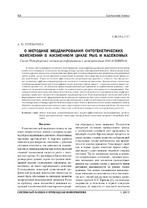| dc.contributor.author | Переварюха, А. Ю. | ru |
| dc.coverage.spatial | Минск | ru |
| dc.date.accessioned | 2017-05-11T13:49:50Z | |
| dc.date.available | 2017-05-11T13:49:50Z | |
| dc.date.issued | 2017 | |
| dc.identifier.citation | Переварюха, А. Ю. О методике моделирования онтогенетических изменений в жизненном цикле рыб и насекомых = On the technique of modeling ontogenetic changes in fish and insects lifecycle / А. Ю. Переварюха // Системный анализ и прикладная информатика. - 2017. – № 1. - С. 12 -23. | ru |
| dc.identifier.uri | https://rep.bntu.by/handle/data/29736 | |
| dc.description.abstract | В статье рассматривается подход к моделированию метаморфозов в развитии ряда биологических видов в контексте влияния их успешности на долговременные тренды популяционной динамики. Изменения выживаемости в раннем онтогенезе, контролируемые фактором темпов индивидуального развития в конкурирующей группе особей, могут стать причиной неожиданной деградации популяции при малом избыточном промысловом воздействии. Теория нелинейной эффективности воспроизводства выводит к гипотезе, что два различных нелинейных эффекта контролируются на самом деле схожими механизмами. Для насекомых аналогичные колебания выживаемости при метаморфозах могут запускать другой процесс – стремительной вспышки численности вредителей, где актуальна формализация воздействия паразитов на первой стадии развития, зависящая от начальной концентрации кладок, но ограниченность ресурсов учитывается на завершающей. Рассмотрен метод представления убыли поколений на основе систем динамически переопределяемых дифференциальных уравнений с дискретно-непрерывной структурой времени. В расширении ранее предложенной модели формирования поколений сформирована вычислительная структура для учета зависимости смертности от уровня конкуренции, дополненная триггерным функционалом и новой схемой описания изменений скорости роста для примера осетровых рыб Каспийского моря на трех эколого-физиологических этапах развития. Модель обладает нетривиальными возможностями в параметрическом изменении режимов поведения. Сосуществование альтернативных циклов находит объяснение в адаптивном возрастании внутривидовых различий. | ru |
| dc.language.iso | ru | ru |
| dc.publisher | БНТУ | ru |
| dc.subject | Модели популяций | ru |
| dc.subject | Репродуктивный цикл | ru |
| dc.subject | Воспроизводство - теория эффективности | ru |
| dc.subject | Предикативно переопределяемые структуры | ru |
| dc.subject | Онтогенез - ранний - этапы | ru |
| dc.subject | Популяция - вспышки | ru |
| dc.subject | Популяция - деградация | ru |
| dc.subject | Models of populations | en |
| dc.subject | Reproductive cycle | en |
| dc.subject | Theory of efficiency of reproduction | en |
| dc.subject | Redefined predicative structure | en |
| dc.subject | Stages of early ontogeny | en |
| dc.subject | Outbreaks and populations degradation | en |
| dc.title | О методике моделирования онтогенетических изменений в жизненном цикле рыб и насекомых | ru |
| dc.title.alternative | On the technique of modeling ontogenetic changes in fish and insects lifecycle | en |
| dc.type | Article | ru |
| dc.relation.journal | Системный анализ и прикладная информатика | ru |
| local.description.annotation | The article discusses the approach to modeling of metamorphoses in the development of a number of species in the context of their influence on the success of long-term trends of population dynamics. Changes in survival during early ontogenesis, controlled by important factor – the rate of individual development in a competing group of individuals, can cause unexpected degradation of population with a small excess fishing impact. The theory of nonlinear efficiency of reproduction leads us to the hypothesis that two different nonlinear effects are controlled by similar mechanisms. For insects such fluctuations in survival during metamorphosis can start another process - the rapid outbreak of pests, where actual formalization of the impact of parasites on the first stage of development, depending on the initial concentration of clutches, but limited resources is taken into account at a finishing. The method has been for submission to decline of generations on the basis of dynamic overriding differential equations with discrete-continuous structure of time. To extend the previously proposed model for the formation of generations is formed computing structure for the account mortality depending on the level of competition, complete with trigger functional and a new scheme describing the changes the growth rate for the example of the Caspian Sea sturgeon in three ecological and physiological stages of development. The new model has a non-trivial possibilities parametrically modification of behavior regimes. The coexistence of alternative cycles is explained by the increase in adaptive interspecies differences. | en |

